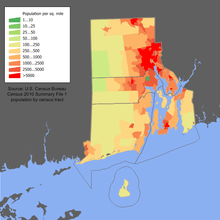Solar power in Rhode Island

Solar power in Rhode Island has become economical due to new technological improvements and a variety of regulatory actions and financial incentives, particularly a 30% federal tax credit, available through 2016, for any size project. A typical residential installation could pay for itself in utility bill savings in 14 years, and generate a profit for the remainder of its 25 year life. Larger systems, from 10 kW to 5 MW, receive a feed-in tariff of up to 33.45¢/kWh.[1][2]
Due to the state's small size and comparatively low insolation, solar installations are limited to predominantly rooftop and megawatt scale installations. Approximately 23% of electricity used in Rhode Island could be provided from rooftop solar panels.[3] A 10 to 15 MW photovoltaic power plant is planned for a former landfill in East Providence.[4]
Government policy
The Government of Rhode Island has taken a variety of actions in order to encourage solar energy use within the state. Nineteen schools have installed a 2 kW or larger solar panel that can be monitored on the Internet, similar to the programs in Australia and New Zealand.[5] A variety of solar arrays have been installed at state facilities, which can also be monitored.[6][7]
Net metering
The state has a net metering program that allows installations of up to 5 MW of on-site electrical generation to continuously roll over any excess generation to the next month, or purchased at avoided cost. Participation is limited to 3% of utilities peak demand for Block Island Power Company and Pascoag Utility District. National Grid has no limit.[8] Peak demand for the state for 2011 was 21,477 MW.[9]
Renewable portfolio standard
The state adopted a Renewable Portfolio Standard (RPS) in 2004 which requires that 16% of Rhode Island's electricity come from renewable resources by 2019.[10]
Installed capacity
| Year | Capacity | Change | % Change |
|---|---|---|---|
| 2007 | 0.6 | ||
| 2008 | 0.6 | ||
| 2009 | 0.6 | ||
| 2010 | 0.6 | ||
| 2011 | 1.2 | 0.6 | 100% |
| 2012 | 1.9 | 0.7 | 58% |
| 2013 | 7.6 | 5.7 | 300% |
| 2014 | 12.6 | 5.0 | 66% |
| 2015 | 17.1 | 4.5 | 36% |
See also
References
- ↑ Rhode Island State Solar Power Rebates, Tax Credits, and Incentives
- ↑ Distributed Generation Standard Contracts
- ↑ Report Argues for a Decentralized System of Renewable Power Generation
- ↑ R.I. EDC approves grant, loan for solar-power project, Bristol repair shop
- ↑ Solar Installation Map
- ↑ RI lands $1.5M to install solar panels on state property
- ↑ News Release
- ↑ "Rhode Island - Net Metering". Retrieved 2012-06-08.
- ↑ Semiannual Projections of Energy Supply and Demand Winter Outlook 2011- 2012
- ↑ "Renewable Energy Standard". 2011-08-10. Retrieved 2012-06-08.
- ↑ Sherwood, Larry (August 2012). "U.S. Solar Market Trends 2011" (PDF). Interstate Renewable Energy Council (IREC). p. 17. Retrieved 2012-08-16.
- ↑ Sherwood, Larry (June 2011). "U.S. Solar Market Trends 2010" (PDF). Interstate Renewable Energy Council (IREC). p. 20. Retrieved 2011-06-29.
- ↑ Sherwood, Larry (July 2010). "U.S. Solar Market Trends 2009" (PDF). Interstate Renewable Energy Council (IREC). p. 23. Retrieved 2010-07-28.
- ↑ Sherwood, Larry (July 2009). "U.S. Solar Market Trends 2008" (PDF). Interstate Renewable Energy Council (IREC). p. 16. Retrieved 2010-07-24.
- ↑ Sherwood, Larry (July 2009). "U.S. Solar Market Trends 2008" (PDF). Interstate Renewable Energy Council (IREC). p. 16. Retrieved 2010-07-24.
- ↑ Sherwood, Larry (July 2012). "U.S. Solar Market Trends 2012" (PDF). Interstate Renewable Energy Council (IREC). p. 16. Retrieved 2013-10-11.
- ↑ Sherwood, Larry (July 2014). "U.S. Solar Market Trends 2013" (PDF). Interstate Renewable Energy Council (IREC). Retrieved 2014-09-26.
- ↑ Rhode Island Solar